I am plotting a heatmap that have many values set to zero, a few that are very low (0.001 to 0.05) and a few that are high (>0.9 up to 1). Is it possible to set a non-uniform colorbar spacing so the data can be better understood? How can that be done?
data = {(0, 33): 0.002, (0, 34): 0.007, (0, 35): 0.015, (0, 36): 0.014, (0, 37): 0.943, (0, 38): 0.01, (0, 51): 0.007, (1, 33): 0.002, (1, 34): 0.002, (1, 35): 0.005, (1, 36): 0.005, (1, 37): 0.977, (1, 38): 0.006, (1, 51): 0.003, (2, 34): 0.002, (2, 35): 0.003, (2, 36): 0.003, (2, 37): 0.99, (2, 38): 0.002, (3, 33): 0.002, (3, 34): 0.003, (3, 35): 0.005, (3, 36): 0.007, (3, 37): 0.978, (3, 38): 0.005, (3, 51): 0.001, (4, 37): 1.0, (5, 37): 1.0, (12, 33): 0.003, (12, 34): 0.004, (12, 35): 0.018, (12, 36): 0.017, (12, 37): 0.931, (12, 38): 0.013, (12, 49): 0.001, (12, 51): 0.012, (13, 33): 0.003, (13, 34): 0.004, (13, 35): 0.009, (13, 36): 0.013, (13, 37): 0.944, (13, 38): 0.014, (13, 51): 0.012, (14, 34): 0.001, (14, 35): 0.002, (14, 36): 0.003, (14, 37): 0.993, (14, 38): 0.001, (15, 34): 0.001, (15, 35): 0.002, (15, 36): 0.003, (15, 37): 0.992, (15, 38): 0.001, (16, 37): 0.996, (16, 38): 0.004, (17, 37): 1.0, (18, 37): 1.0, (19, 37): 1.0, (20, 37): 1.0, (21, 37): 1.0, (22, 37): 1.0, (23, 37): 1.0, (24, 33): 0.004, (24, 34): 0.007, (24, 35): 0.032, (24, 36): 0.035, (24, 37): 0.903, (24, 38): 0.016, (24, 51): 0.003, (25, 33): 0.004, (25, 34): 0.006, (25, 35): 0.029, (25, 36): 0.034, (25, 37): 0.907, (25, 38): 0.016, (25, 51): 0.003, (26, 35): 0.004, (26, 36): 0.007, (26, 37): 0.972, (26, 38): 0.017, (27, 33): 0.004, (27, 34): 0.005, (27, 35): 0.007, (27, 36): 0.008, (27, 37): 0.961, (27, 38): 0.016, (28, 33): 0.005, (28, 34): 0.006, (28, 35): 0.008, (28, 36): 0.01, (28, 37): 0.961, (28, 38): 0.01, (29, 33): 0.002, (29, 34): 0.003, (29, 35): 0.023, (29, 36): 0.016, (29, 37): 0.943, (29, 38): 0.012, (30, 33): 0.001, (30, 35): 0.01, (30, 36): 0.001, (30, 37): 0.985, (30, 38): 0.004, (35, 37): 1.0, (36, 37): 1.0, (37, 37): 1.0, (38, 38): 1.0, (39, 49): 0.013, (39, 50): 0.012, (39, 51): 0.975, (40, 47): 0.18, (40, 49): 0.02, (40, 50): 0.126, (40, 51): 0.674, (41, 49): 0.012, (41, 50): 0.022, (41, 51): 0.966}
i_set, j_set = set(), set()
for k in data.keys():
i_set.add(k[0])
j_set.add(k[1])
i_set = list(i_set)
i_set.sort()
j_set = list(j_set)
j_set.sort()
# Make array
array = []
for i in i_set:
row = []
for j in j_set:
row.append( data.get((i,j), 0) )
array.append(row)
array = np.array(array)
# plot
fig, ax = plt.subplots()
im = ax.imshow(array)
# We want to show all ticks...
ax.set_xticks(np.arange(len(j_set)))
ax.set_yticks(np.arange(len(i_set)))
# ... and label them with the respective list entries
ax.set_xticklabels(j_set)
ax.set_yticklabels(i_set)
# Rotate the tick labels and set their alignment.
plt.setp(ax.get_xticklabels(), rotation=45, ha="right", rotation_mode="anchor")
# Loop over data dimensions and create text annotations.
for i in range(len(i_set)):
for j in range(len(j_set)):
if array[i,j] != 0:
text = ax.text(j, i, array[i, j],
ha="center", va="center", color="w", fontsize='xx-small')
fig.tight_layout()
plt.show()
Furthermore, the top and bottom rows are "cut in half" instead of shown in full. How can I fix that?
EDIT The last question, of how to fix the cut in half squares was solved. Still, the question on how to make the colorbar vary non-uniformly is open!
